Android Tablet Usb C Blue Teardrop Connection Error
Samsung Galaxy A33 5G review: Better than its predecessor in almost every area
Success model. With its Galaxy A33 5G, Samsung has identified and remedied the weaknesses of the Galaxy A32 5G predecessor. With a 90 Hz AMOLED display, a more modern SoC and a waterproof case, the mid-range smartphone even comes dangerously close to matching the Galaxy A53 5G.
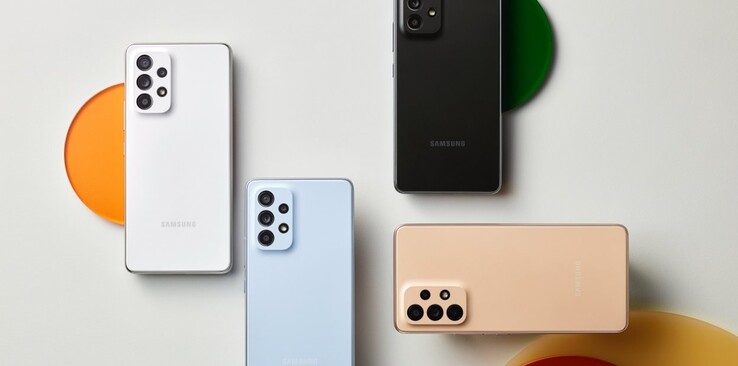
Samsung is relaunching its smartphones from the successful Galaxy A series. Due to high demand, the Galaxy A smartphones have only slowly evolved over the past few years, so why change a successful formula? This year, however, things are somewhat different, as our Galaxy A33 5G review sample shows.
The Galaxy A33 5G contains a few improvements over its Galaxy A32 5G predecessor. Aside from the the slightly smaller form factor (now 6.4 instead of 6.5 inches), the biggest change is the screen: Instead of a low-contrast TFT-LCD, an AMOLED screen is used. A more modern SoC and IP67 certification have also been thrown in.
Display
6.40 inch 20:9, 2400 x 1080 pixel 411 PPI, capacitive, Super AMOLED, FHD+, HDR10, 16M colors, glossy: yes, HDR, 90 Hz
Storage
128 GB UFS 2.2 Flash, 128 GB
, 98.4 GB free
Weight
186 g ( = 6.56 oz / 0.41 pounds) ( = 0 oz / 0 pounds)
Note: The manufacturer may use components from different suppliers including display panels, drives or memory sticks with similar specifications.
| Rating | Date | Model | Weight | Drive | Size | Resolution | Best Price |
|---|---|---|---|---|---|---|---|
| 83 % | 06/2022 | Samsung Galaxy A33 5G Exynos 1280, Mali-G68 MP4 | 186 g | 128 GB UFS 2.2 Flash | 6.40" | 2400x1080 | |
| 85.3 % | 02/2022 | Motorola Moto G200 5G SD 888+ 5G, Adreno 660 | 202 g | 128 GB UFS 3.1 Flash | 6.80" | 2460x1080 | |
| 77.7 % | 06/2022 | Oppo A76 SD 680, Adreno 610 | 189 g | 128 GB UFS 2.2 Flash | 6.56" | 1612x720 | |
| 79.3 % | 03/2021 | Samsung Galaxy A32 5G Dimensity 720, Mali-G57 MP3 | 205 g | 64 GB UFS 2.1 Flash | 6.50" | 1600x720 | |
| 83.2 % | 06/2022 | Samsung Galaxy A53 Exynos 1280, Mali-G68 MP4 | 189 g | 128 GB UFS 2.1 Flash | 6.50" | 2400x1080 | |
| 80.5 % | 01/2022 | Xiaomi Poco M4 Pro 5G Dimensity 810, Mali-G57 MP2 | 195 g | 128 GB UFS 2.2 Flash | 6.60" | 2400x1080 |
In terms of case, the Samsung Galaxy A33 5G resembles the Galaxy A32 5G nearly down to the last detail, except for the different form factor. Buyers still get a high-quality and stable plastic chassis, the front of which is protected by Gorilla Glass 5. The selfie camera is nested in a teardrop-shaped recess.
The front and back of the Galaxy A33 5G, which is available in white, black, light blue and a bright peach orange, are held together by a smooth and glossy frame. The matte back cover is slightly rubberized, which makes the smartphone feel very good to use. The weight amounts to a light 186 grams.
While the arrangement of the 4 lenses on the back has not changed compared to the Galaxy A32 5G, the design is different. The camera module no longer sits flat in the casing, but clearly protrudes outwards, with the edges blending smoothly into the back cover. Another new feature is the IP67 certification against dust and water.
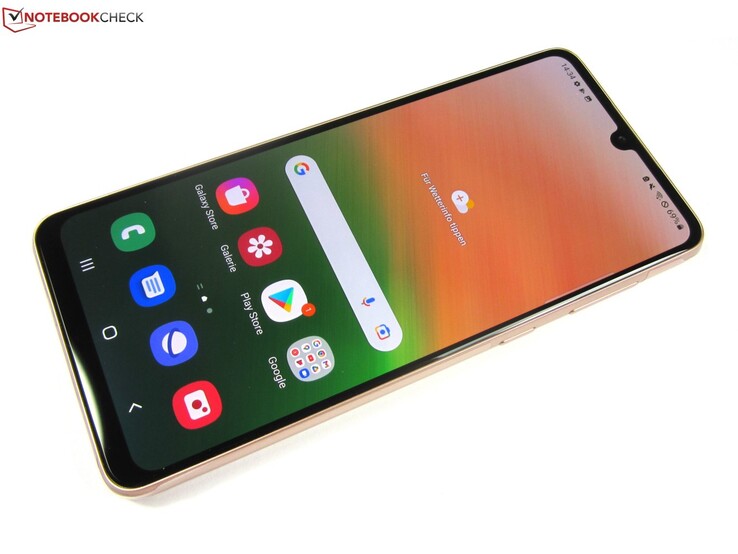
❌
Samsung offers the Galaxy A33 5G in only one configuration: 6 GB RAM and 128 GB UFS 2.2 storage for around US$ 270. The actual storage space amounts to 98 GB in brand new or factory state.
Samsung has removed the 3.5 mm jack of the predecessor, so wired audio devices can only be used via a USB-C adapter. In addition to NFC, the smartphone also contains Bluetooth 5.1 and thus a somewhat more up-to-date version of the wireless communication standard (Galaxy A32 5G: Bluetooth 5.0). The OTG-enabled USB-C port works at USB 2.0 speed.
The Galaxy A33 5G supports DRM Widevine L1, but the Camera2 API only comes with the support level "Limited". Third-party camera apps that are installed therefore have limited access to the camera features.
The microSD/SIM slot can accommodate either a microSD card and a nano-SIM card or two nano-SIM cards. With our Angelbird AV Pro V60 microSD reference card, the Galaxy A33 5G achieves solid read and write performance rates that are slightly higher overall than the Galaxy A32 5G.
| SD Card Reader - average JPG Copy Test (av. of 3 runs) | |
| Samsung Galaxy A33 5G (Angelbird AV Pro V60) | |
| Oppo A76 (Angelbird V60) | |
| Xiaomi Poco M4 Pro 5G (Angelbird AV Pro V60) | |
| Samsung Galaxy A53 (Angelbird V60) | |
Samsung Galaxy A33 5G Mali-G68 MP4, Exynos 1280, 128 GB UFS 2.2 Flash; SDCard Sequential Write 0.5 GB; Angelbird AV Pro V60: Ø43.7 (29-56.7)
Oppo A76 Adreno 610, SD 680, 128 GB UFS 2.2 Flash; SDCard Sequential Write 0.5 GB; Angelbird V60: Ø38.7 (29.6-50.5)
Samsung Galaxy A53 Mali-G68 MP4, Exynos 1280, 128 GB UFS 2.1 Flash; SDCard Sequential Write 0.5 GB: Ø46.2 (35.3-62.3)
Xiaomi Poco M4 Pro 5G Mali-G57 MP2, Dimensity 810, 128 GB UFS 2.2 Flash; SDCard Sequential Write 0.5 GB; Angelbird AV Pro V60: Ø32 (25-46.5)
Samsung Galaxy A33 5G Mali-G68 MP4, Exynos 1280, 128 GB UFS 2.2 Flash; SDCard Sequential Read 0.5 GB; Angelbird AV Pro V60: Ø83.8 (43.5-112.8)
Oppo A76 Adreno 610, SD 680, 128 GB UFS 2.2 Flash; SDCard Sequential Read 0.5 GB; Angelbird V60: Ø75.8 (36.1-83.9)
Samsung Galaxy A53 Mali-G68 MP4, Exynos 1280, 128 GB UFS 2.1 Flash; SDCard Sequential Read 0.5 GB: Ø83.9 (56.1-108.6)
Xiaomi Poco M4 Pro 5G Mali-G57 MP2, Dimensity 810, 128 GB UFS 2.2 Flash; SDCard Sequential Read 0.5 GB; Angelbird AV Pro V60: Ø75.5 (58.6-78.9)
Samsung equips the Galaxy A33 5G with Android 12 and its in-house One UI 4.1 user interface. At the time of review (end of June), the Android security patches were still from April 1 and thus not quite up to date.
Aside from the obligatory Google apps and a collection of proprietary apps, only a handful of third-party apps such as Facebook, TikTok and Spotify are preinstalled. Excluding Microsoft OneDrive, all of these can be uninstalled.
Samsung is focusing on longevity for its current smartphone and tablet generation, promising up to four generations of Android OS upgrades as well as five years of security updates. No other manufacturer in the Android field currently offers more.
With seventeen 4G bands and twelve 5G bands, Samsung's Galaxy A33 5G offers good mobile coverage, so reception problems should hardly ever occur.
The smartphone communicates via WiFi 5 in local networks, but does not make use of MIMO antenna technology to speed up data transfers. The WLAN transfer rates determined with our Asus ROG Rapture GT-AXE11000 reference router are therefore not exactly inspiring. However, they fall well within the range of what can be expected from WiFi 5 and are very stable in both the send and receive directions.
| Networking | |
| iperf3 receive AXE11000 | |
| Average of class Smartphone (72.5 - 1736, n=58, last 2 years) | |
| Samsung Galaxy A53 | |
| Samsung Galaxy A33 5G | |
| Oppo A76 | |
| iperf3 transmit AXE11000 | |
| Average of class Smartphone (78.3 - 1710, n=58, last 2 years) | |
| Oppo A76 | |
| Samsung Galaxy A53 | |
| Samsung Galaxy A33 5G | |
| iperf3 transmit AX12 | |
| Motorola Moto G200 5G | |
| Average of class Smartphone (5.59 - 1395, n=206, last 2 years) | |
| Samsung Galaxy A32 5G | |
| iperf3 receive AX12 | |
| Motorola Moto G200 5G | |
| Average of class Smartphone (15.5 - 1348, n=206, last 2 years) | |
| Samsung Galaxy A32 5G | |
; iperf3 receive AXE11000; iperf 3.1.3: Ø342 (337-348)
; iperf3 transmit AXE11000; iperf 3.1.3: Ø263 (133-280)
Localization of the Galaxy A33 5G takes place via GPS (L1), Galileo (E1), Glonass (L1), Beidou (B1) and QZSS with an accuracy of up to 4 meters indoors and up to 3 meters outdoors.
The Galaxy A33 5G also provides rather accurate positioning data in everyday use. Compared with the Garmin Venu 2, it recorded our approximately 10-kilometer bike ride almost just as precisely.
The Galaxy A33 5G delivers solid voice quality and can suppress loud ambient noise quite efficiently. Communication via the speaker also works quite well. However, voices become a bit muffled when we move further away from the microphone. The same happens when we speak quietly.
Either two nano-SIM cards or one nano-SIM card and one microSD card fit into the smartphone's hybrid slot. VoLTE and WLAN calling are supported.

In terms of official specs, the Samsung Galaxy A33 5G has almost the same camera equipment as the Galaxy A32 5G, but the 48 MP main camera now has an optical image stabilizer that makes taking pictures easier. The remaining lenses on the back cover are occupied by an 8 MP ultra-wide-angle camera (F2.2), a 5 MP macro camera (F2.4) and a 2 MP depth camera (F.2.4).
The main camera (F1.8, AF, OIS) takes 12 MP photos in standard mode via pixel binning. In daylight, photos are good and detailed, but lose some sharpness at the edges and are distorted by image artifacts when zooming. The activation of night mode can provide for decent pictures in low-light conditions, but dark areas could use more lighting. Overall, the image quality is absolutely fine for mid-range conditions as long as you are content with the strong colors that are typical of Samsung's smartphones.
The rest of the camera setup lags somewhat behind the main camera. Images with the ultra-wide-angle camera are clearly distorted towards the edges and quickly become pixelated when zooming in. The 2 MP macro camera, which works with a focus range of 3 to 5 centimeters, can take interesting pictures, but they are not so detailed due to the low resolution.
The selfie camera has a resolution of 13 MP, delivers a solid image quality and produces decent blur effects in portrait mode. Like the main camera, it can record videos in 4K UHD at 30 FPS. However, video stabilization only works up to a maximum of 1080p at 30 FPS in both cases, just like switching between the main camera and the ultra-wide-angle camera during recording.
Image Comparison
Choose a scene and navigate within the first image. One click changes the position on touchscreens. One click on the zoomed-in image opens the original in a new window. The first image shows the scaled photograph of the test device.
Tageslicht-Aufnahme 1Tageslicht-Aufnahme 2Ultraweitwinkel5-facher ZoomLowlight-Aufnahme

click to load images
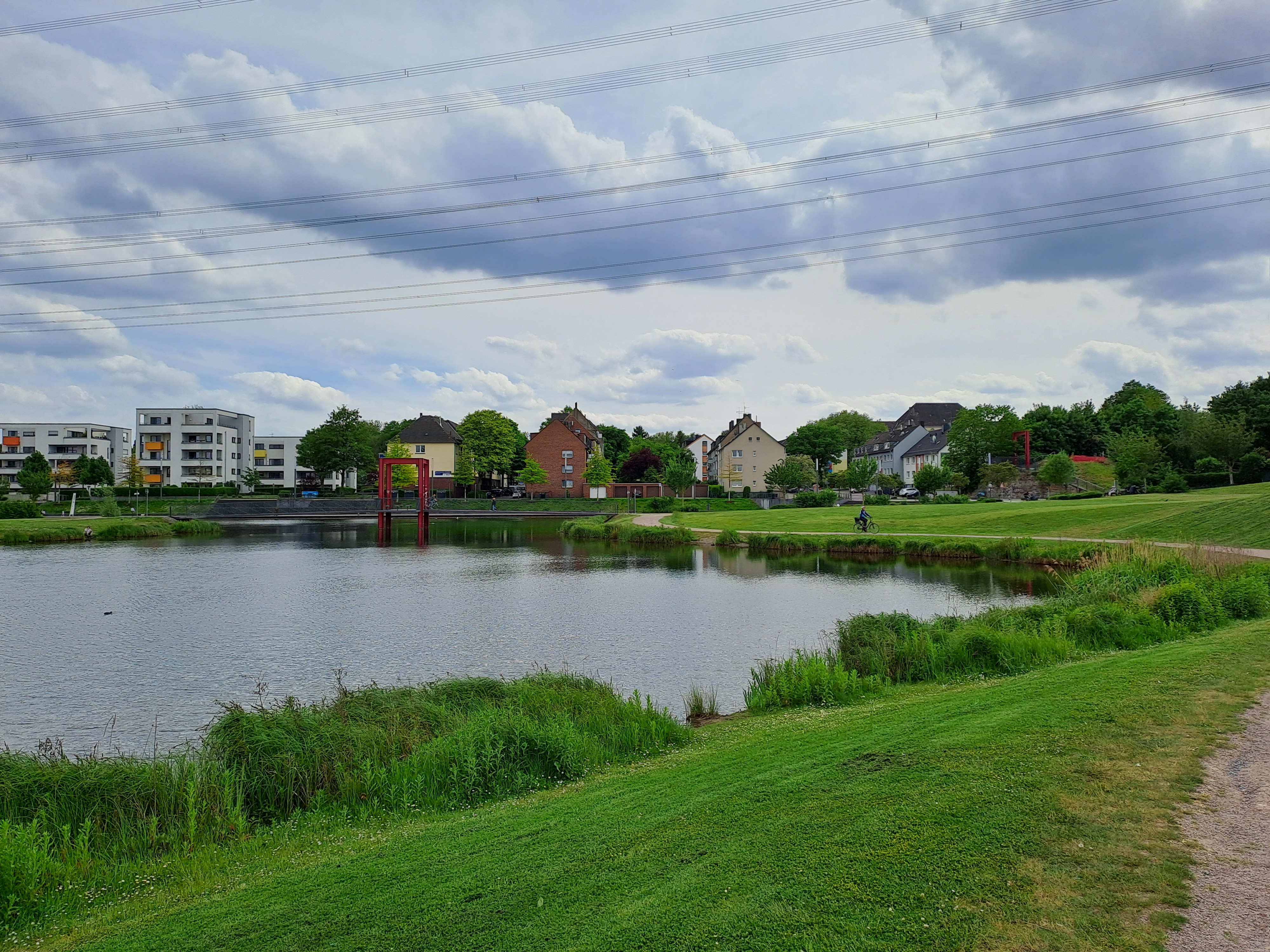
click to load images
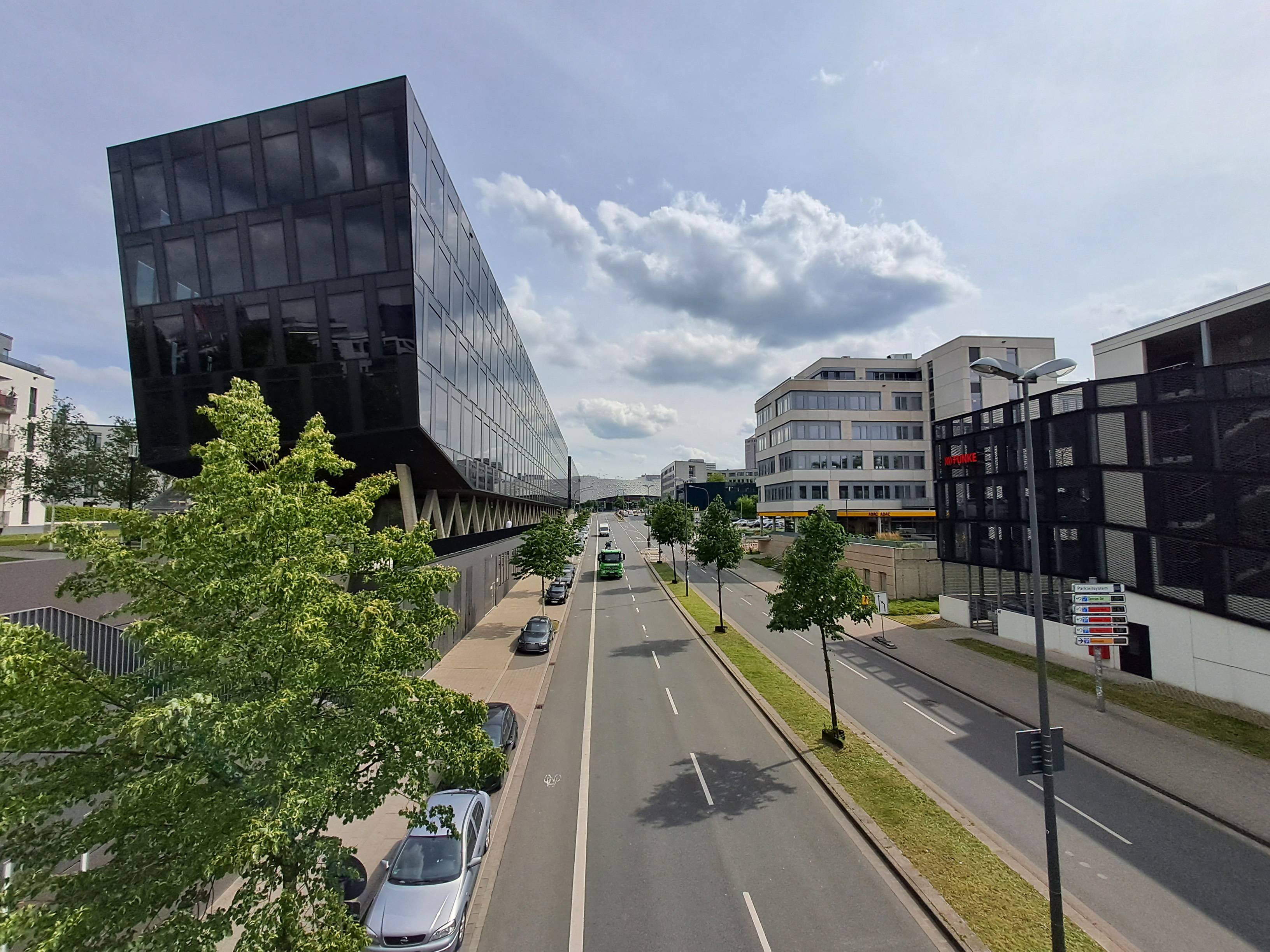
click to load images

click to load images

click to load images
Apart from a deviation in the green tones, the Galaxy A33 5G manages a fairly accurate color reproduction under laboratory conditions, but can only sharply reproduce the test chart in the center of the image. On the other hand, this can still be recognized in residual light of 1 lux, even if only in outlines.
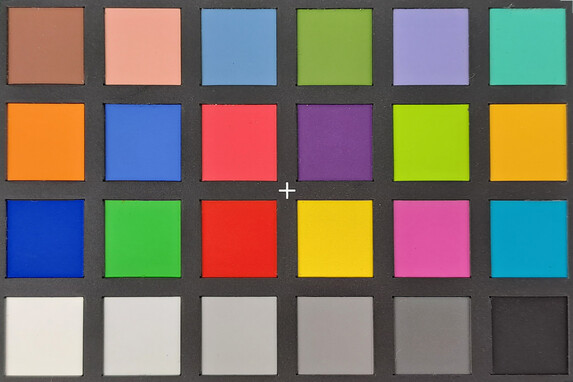
17.6 ∆E
8.2 ∆E
11 ∆E
24.4 ∆E
7.2 ∆E
3.2 ∆E
6.8 ∆E
11.8 ∆E
10.8 ∆E
8.2 ∆E
7.1 ∆E
4 ∆E
5.7 ∆E
14.7 ∆E
14.3 ∆E
1.5 ∆E
7.1 ∆E
8.9 ∆E
5.9 ∆E
3.9 ∆E
7.8 ∆E
12.6 ∆E
15.3 ∆E
3.5 ∆E
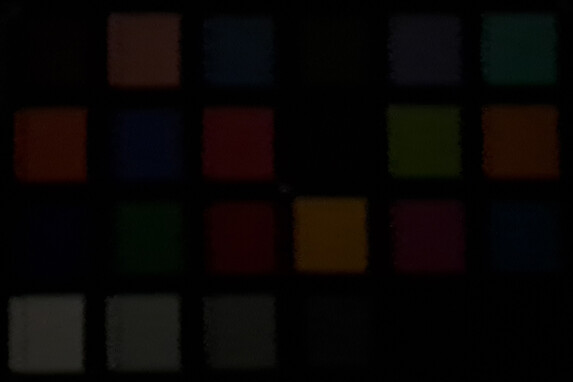
29.6 ∆E
49.6 ∆E
37.9 ∆E
34.6 ∆E
43.4 ∆E
58.9 ∆E
49.9 ∆E
33.2 ∆E
37.8 ∆E
29.4 ∆E
60.1 ∆E
61.5 ∆E
30.6 ∆E
45.8 ∆E
33.8 ∆E
71.8 ∆E
41.4 ∆E
41.8 ∆E
76.2 ∆E
67.9 ∆E
50.5 ∆E
36.9 ∆E
24.4 ∆E
13.9 ∆E
As indicated by the slim packaging of the Samsung Galaxy A33 5G, a power adapter is not included in the scope of delivery. Buyers receive a USB cable (type A to C), a SIM tool, a quick start guide and a warranty information leaflet. Further accessories such as a 25-watt power adapter can be purchased in the Samsung shop.
The Galaxy A33 5G comes with a 24-month warranty in Germany. This may vary in other countries and other regions, so be sure to check with your supplier before buying. Unlike the Galaxy A53 5G, Samsung Care+ insurance is not available for the smartphone.
Thanks to the precise touchscreen with its 90 Hz refresh rate, the Samsung Galaxy A33 5G is comfortable and smooth to use. However, delays or small stutters can occur upon booting and when many apps are open at the same time, despite 6 GB of RAM. All in all, this is not so annoying, but it clearly shows that the smartphone does not have the fastest SoC.
The Galaxy A33 5G can be unlocked quickly and reliably via the optical fingerprint sensor integrated into the display. The second biometric authentication method is the 2D face scan, which performs well with a high recognition rate even in low ambient light, but is not quite as secure as the fingerprint method.

In terms of display, the Galaxy A33 5G makes a big leap forward compared to its predecessor. While the Galaxy A32 5G had to make do with a low-resolution TFT-LCD screen and a framerate of 60 Hz, Samsung has flipped things around with the successor.
The Galaxy A33 5G offers a bright 90 Hz AMOLED screen with a resolution of 2400 x 1080, the same as its 6.5-inch Galaxy A sister model, the Galaxy A53 5G. This also provides our 6.4-inch review sample with a high pixel density of 441 PPI, which makes displayed content nice and sharp.
On average, the AMOLED panel achieves a luminance of around 695 cd/m², which is practically as bright as the screen of the Galaxy A53 5G. We even get up to 1092 cd/m² from the screen in evenly distributed bright and dark areas (APL18 measurement). Without the brightness sensor, the luminance drops to a maximum of 387 cd/m². At the lowest brightness setting, the screen still shines with 2.2 cd/m², or 1.82 cd/m² when you activate the extra dimming in the Android settings under "Input Help".
The AMOLED screen flickers in a range of 178.1 to 366.2 Hz, which should not bother most users. A DC dimming mode that counteracts the PWM flickering is not available in the Android settings.
| 689 cd/m² | 691 cd/m² | 695 cd/m² | ||
| 691 cd/m² | 693 cd/m² | 697 cd/m² | ||
| 695 cd/m² | 699 cd/m² | 701 cd/m² | ||
Distribution of brightness
X-Rite i1Pro 3
Maximum: 701 cd/m² (Nits) Average: 694.6 cd/m² Minimum: 1.82 cd/m²
Brightness Distribution: 98 %
Center on Battery: 693 cd/m²
Contrast: ∞:1 (Black: 0 cd/m²)
ΔE Color 1.3 | 0.59-29.43 Ø5.3
ΔE Greyscale 1.3 | 0.64-98 Ø5.6
98.3% sRGB (Calman 2D)
Gamma: 2.14
| Samsung Galaxy A33 5G Super AMOLED, 2400x1080, 6.40 | Motorola Moto G200 5G IPS LCD, 2460x1080, 6.80 | Oppo A76 IPS, 1612x720, 6.56 | Samsung Galaxy A32 5G TFT-LCD, 1600x720, 6.50 | Samsung Galaxy A53 AMOLED, 2400x1080, 6.50 | Xiaomi Poco M4 Pro 5G TFT-LCD, 2400x1080, 6.60 | |
|---|---|---|---|---|---|---|
| Screen | -81% | -24% | -145% | -16% | -84% | |
| Brightness middle | 693 | 512 -26% | 569 -18% | 543 -22% | 718 4% | 504 -27% |
| Brightness | 695 | 488 -30% | 562 -19% | 512 -26% | 730 5% | 499 -28% |
| Brightness Distribution | 98 | 87 -11% | 90 -8% | 85 -13% | 92 -6% | 91 -7% |
| Black Level * | 0.36 | 0.5 | 0.63 | 0.72 | ||
| Colorchecker dE 2000 * | 1.3 | 3.42 -163% | 2.16 -66% | 4.9 -277% | 1.62 -25% | 3.3 -154% |
| Colorchecker dE 2000 max. * | 3.5 | 5.9 -69% | 3.37 4% | 8.6 -146% | 4.21 -20% | 6 -71% |
| Greyscale dE 2000 * | 1.3 | 3.7 -185% | 1.8 -38% | 6.3 -385% | 2 -54% | 4.1 -215% |
| Gamma | 2.14 103% | 7154 0% | 2.177 101% | 2.23 99% | 2.156 102% | 2.28 96% |
| CCT | 6530 100% | 1.944 334362% | 6784 96% | 8120 80% | 6545 99% | 7041 92% |
| Contrast | 1422 | 1138 | 862 | 700 |
* ... smaller is better
Screen Flickering / PWM (Pulse-Width Modulation)
ℹ
To dim the screen, some notebooks will simply cycle the backlight on and off in rapid succession - a method called Pulse Width Modulation (PWM) . This cycling frequency should ideally be undetectable to the human eye. If said frequency is too low, users with sensitive eyes may experience strain or headaches or even notice the flickering altogether.
| Screen flickering / PWM detected | 366.2 Hz | 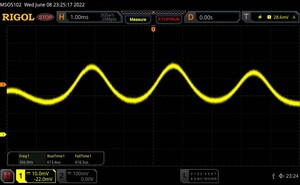 | |
| The display backlight flickers at 366.2 Hz (Likely utilizing PWM) . The frequency of 366.2 Hz is relatively high, so most users sensitive to PWM should not notice any flickering. However, there are reports that some users are still sensitive to PWM at 500 Hz and above, so be aware. In comparison: 52 % of all tested devices do not use PWM to dim the display. If PWM was detected, an average of 21751 (minimum: 5 - maximum: 3846000) Hz was measured. | |||
Messreihe mit fixer Zoomstufe und unterschiedlichen Helligkeitseinstellungen
In the preset picture mode "Vivid", the Galaxy A33 5G gives off a bright representation of colors in the foreground, where color precision only plays a subordinate role. However, whether the colors are precise or not can harly been seen with the naked eye. If you switch to the second picture mode "Natural", the measurement values given by CalMAN are also good: The color accuracy with a maximum Delta-E of 1.3 falls into the ideal range, as well as the RGB balance and the color temperature.
Display Response Times
ℹ
Display response times show how fast the screen is able to change from one color to the next. Slow response times can lead to afterimages and can cause moving objects to appear blurry (ghosting). Gamers of fast-paced 3D titles should pay special attention to fast response times.
| ↔ Response Time Black to White | ||
|---|---|---|
| 1.25 ms ... rise ↗ and fall ↘ combined | ↗ 0.623 ms rise | 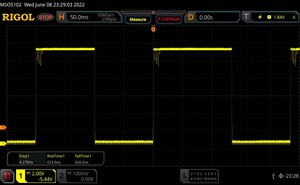 |
| ↘ 0.627 ms fall | ||
| The screen shows very fast response rates in our tests and should be very well suited for fast-paced gaming. In comparison, all tested devices range from 0.8 (minimum) to 240 (maximum) ms. » 0 % of all devices are better. This means that the measured response time is better than the average of all tested devices (23.3 ms). | ||
| ↔ Response Time 50% Grey to 80% Grey | ||
| 1.303 ms ... rise ↗ and fall ↘ combined | ↗ 0.627 ms rise | 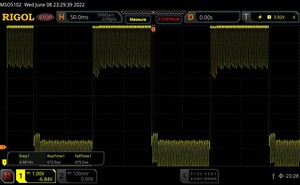 |
| ↘ 0.676 ms fall | ||
| The screen shows very fast response rates in our tests and should be very well suited for fast-paced gaming. In comparison, all tested devices range from 0.692 (minimum) to 636 (maximum) ms. » 1 % of all devices are better. This means that the measured response time is better than the average of all tested devices (36.7 ms). | ||
The Samsung Galaxy A33 5G can be used well outdoors. However, screen content is difficult to read in direct sunlight due to the strong reflection. In the shade, the display is flawless.
Content can be recognized well from all viewing angles. As is typical for AMOLED, there can be slight greenish or yellowish discolorations and/or a slight drop in brightness, but this does not decisively affect legibility.

While the Galaxy A32 5G is powered by a MediaTek Dimensity 720, Samsung uses its own Exynos 1280 for the Galaxy A33 5G. This also uses 8 cores and runs a little faster, but does not have a clear edge over other mid-range SoCs. AImark's AI calculations do not favor the Exynos 1280 at all, as it falls behind most of its other competitors - even the MediaTek Dimensity 720 scores better here.
| Geekbench 5.4 | |
| Single-Core | |
| Motorola Moto G200 5G | |
| realme 9 Pro Plus | |
| Samsung Galaxy A53 | |
| Average Samsung Exynos 1280 (737 - 740, n=2) | |
| Samsung Galaxy A33 5G | |
| Average of class Smartphone (58 - 1755, n=258, last 2 years) | |
| Xiaomi Poco M4 Pro 5G | |
| Samsung Galaxy A32 5G | |
| Oppo A76 | |
| Multi-Core | |
| Motorola Moto G200 5G | |
| Average of class Smartphone (248 - 4914, n=258, last 2 years) | |
| realme 9 Pro Plus | |
| Samsung Galaxy A33 5G | |
| Average Samsung Exynos 1280 (1878 - 1905, n=2) | |
| Samsung Galaxy A53 | |
| Xiaomi Poco M4 Pro 5G | |
| Oppo A76 | |
| Samsung Galaxy A32 5G | |
| Antutu v9 - Total Score | |
| Motorola Moto G200 5G | |
| Average of class Smartphone (111952 - 1119358, n=115, last 2 years) | |
| realme 9 Pro Plus | |
| Samsung Galaxy A53 | |
| Average Samsung Exynos 1280 (398969 - 409976, n=2) | |
| Samsung Galaxy A33 5G | |
| Xiaomi Poco M4 Pro 5G | |
| PCMark for Android - Work 3.0 | |
| Motorola Moto G200 5G | |
| Samsung Galaxy A53 | |
| Average Samsung Exynos 1280 (11077 - 11470, n=2) | |
| Samsung Galaxy A33 5G | |
| realme 9 Pro Plus | |
| Average of class Smartphone (4436 - 18567, n=153, last 2 years) | |
| Xiaomi Poco M4 Pro 5G | |
| Oppo A76 | |
| BaseMark OS II | |
| Overall | |
| Motorola Moto G200 5G | |
| Average of class Smartphone (895 - 8753, n=173, last 2 years) | |
| Samsung Galaxy A53 | |
| Average Samsung Exynos 1280 (3477 - 3626, n=2) | |
| Samsung Galaxy A33 5G | |
| Xiaomi Poco M4 Pro 5G | |
| Samsung Galaxy A32 5G | |
| System | |
| Motorola Moto G200 5G | |
| Average of class Smartphone (1542 - 19657, n=173, last 2 years) | |
| Samsung Galaxy A33 5G | |
| Average Samsung Exynos 1280 (7157 - 7184, n=2) | |
| Samsung Galaxy A53 | |
| Xiaomi Poco M4 Pro 5G | |
| Samsung Galaxy A32 5G | |
| Memory | |
| Motorola Moto G200 5G | |
| Average of class Smartphone (1012 - 9044, n=173, last 2 years) | |
| Xiaomi Poco M4 Pro 5G | |
| Samsung Galaxy A53 | |
| Average Samsung Exynos 1280 (3829 - 3855, n=2) | |
| Samsung Galaxy A33 5G | |
| Samsung Galaxy A32 5G | |
| Graphics | |
| Motorola Moto G200 5G | |
| Average of class Smartphone (478 - 26660, n=173, last 2 years) | |
| Samsung Galaxy A53 | |
| Average Samsung Exynos 1280 (5104 - 5178, n=2) | |
| Samsung Galaxy A33 5G | |
| Xiaomi Poco M4 Pro 5G | |
| Samsung Galaxy A32 5G | |
| Web | |
| Motorola Moto G200 5G | |
| Average of class Smartphone (718 - 2392, n=173, last 2 years) | |
| Xiaomi Poco M4 Pro 5G | |
| Samsung Galaxy A32 5G | |
| Samsung Galaxy A53 | |
| Average Samsung Exynos 1280 (1041 - 1210, n=2) | |
| Samsung Galaxy A33 5G | |
| AImark - Score v2.x | |
| Motorola Moto G200 5G | |
| Average of class Smartphone (4293 - 286905, n=135, last 2 years) | |
| Samsung Galaxy A32 5G | |
| Xiaomi Poco M4 Pro 5G | |
| Samsung Galaxy A33 5G | |
| Average Samsung Exynos 1280 (4714 - 4926, n=2) | |
| Samsung Galaxy A53 | |
The Exynos 1280 uses a ARM Mali-G68 MP4 for graphics processing. This results in a similar story in the synthetic benchmarks: The smartphone's performance is solid, but somewhat below average for its price range.
| 3DMark / Wild Life Extreme Unlimited | |
| Motorola Moto G200 5G | |
| Samsung Galaxy A53 | |
| Samsung Galaxy A33 5G | |
| Xiaomi Poco M4 Pro 5G | |
| Oppo A76 | |
| 3DMark / Wild Life Extreme | |
| Motorola Moto G200 5G | |
| realme 9 Pro Plus | |
| Samsung Galaxy A53 | |
| Samsung Galaxy A33 5G | |
| Xiaomi Poco M4 Pro 5G | |
| Oppo A76 | |
| 3DMark / Wild Life Unlimited Score | |
| Motorola Moto G200 5G | |
| Samsung Galaxy A53 | |
| realme 9 Pro Plus | |
| Samsung Galaxy A33 5G | |
| Samsung Galaxy A32 5G | |
| Xiaomi Poco M4 Pro 5G | |
| Oppo A76 | |
| 3DMark / Wild Life Score | |
| Motorola Moto G200 5G | |
| realme 9 Pro Plus | |
| Samsung Galaxy A53 | |
| Samsung Galaxy A33 5G | |
| Samsung Galaxy A32 5G | |
| Xiaomi Poco M4 Pro 5G | |
| Oppo A76 | |
| 3DMark / Sling Shot Extreme (Vulkan) Unlimited Physics | |
| Xiaomi Poco M4 Pro 5G | |
| realme 9 Pro Plus | |
| Samsung Galaxy A53 | |
| Samsung Galaxy A32 5G | |
| Samsung Galaxy A33 5G | |
| Oppo A76 | |
| 3DMark / Sling Shot Extreme (Vulkan) Unlimited Graphics | |
| realme 9 Pro Plus | |
| Samsung Galaxy A33 5G | |
| Samsung Galaxy A53 | |
| Samsung Galaxy A32 5G | |
| Xiaomi Poco M4 Pro 5G | |
| Oppo A76 | |
| 3DMark / Sling Shot Extreme (Vulkan) Unlimited | |
| realme 9 Pro Plus | |
| Samsung Galaxy A53 | |
| Samsung Galaxy A33 5G | |
| Samsung Galaxy A32 5G | |
| Xiaomi Poco M4 Pro 5G | |
| Oppo A76 | |
| 3DMark / Sling Shot Extreme (ES 3.1) Unlimited Physics | |
| Motorola Moto G200 5G | |
| Xiaomi Poco M4 Pro 5G | |
| realme 9 Pro Plus | |
| Samsung Galaxy A53 | |
| Samsung Galaxy A33 5G | |
| Samsung Galaxy A32 5G | |
| Oppo A76 | |
| 3DMark / Sling Shot Extreme (ES 3.1) Unlimited Graphics | |
| Motorola Moto G200 5G | |
| realme 9 Pro Plus | |
| Samsung Galaxy A53 | |
| Samsung Galaxy A33 5G | |
| Samsung Galaxy A32 5G | |
| Xiaomi Poco M4 Pro 5G | |
| Oppo A76 | |
| 3DMark / Sling Shot Extreme (ES 3.1) Unlimited | |
| Motorola Moto G200 5G | |
| realme 9 Pro Plus | |
| Samsung Galaxy A53 | |
| Samsung Galaxy A33 5G | |
| Xiaomi Poco M4 Pro 5G | |
| Samsung Galaxy A32 5G | |
| Oppo A76 | |
| 3DMark / Sling Shot OpenGL ES 3.0 Physics | |
| Xiaomi Poco M4 Pro 5G | |
| realme 9 Pro Plus | |
| Samsung Galaxy A33 5G | |
| Samsung Galaxy A32 5G | |
| Samsung Galaxy A53 | |
| 3DMark / Sling Shot OpenGL ES 3.0 Graphics | |
| realme 9 Pro Plus | |
| Samsung Galaxy A33 5G | |
| Samsung Galaxy A53 | |
| Xiaomi Poco M4 Pro 5G | |
| Samsung Galaxy A32 5G | |
| 3DMark / Sling Shot OpenGL ES 3.0 | |
| realme 9 Pro Plus | |
| Samsung Galaxy A33 5G | |
| Samsung Galaxy A53 | |
| Xiaomi Poco M4 Pro 5G | |
| Samsung Galaxy A32 5G | |
| 3DMark / Sling Shot Extreme (ES 3.1) | |
| realme 9 Pro Plus | |
| Samsung Galaxy A53 | |
| Samsung Galaxy A33 5G | |
| Xiaomi Poco M4 Pro 5G | |
| Samsung Galaxy A32 5G | |
| Oppo A76 | |
| 3DMark / Sling Shot Extreme (ES 3.1) Graphics | |
| realme 9 Pro Plus | |
| Samsung Galaxy A53 | |
| Samsung Galaxy A33 5G | |
| Xiaomi Poco M4 Pro 5G | |
| Samsung Galaxy A32 5G | |
| Oppo A76 | |
| 3DMark / Sling Shot Extreme (ES 3.1) Physics | |
| Xiaomi Poco M4 Pro 5G | |
| realme 9 Pro Plus | |
| Oppo A76 | |
| Samsung Galaxy A33 5G | |
| Samsung Galaxy A53 | |
| Samsung Galaxy A32 5G | |
| 3DMark / Sling Shot OpenGL ES 3.0 Unlimited | |
| realme 9 Pro Plus | |
| Samsung Galaxy A53 | |
| Samsung Galaxy A33 5G | |
| Xiaomi Poco M4 Pro 5G | |
| Samsung Galaxy A32 5G | |
| 3DMark / Sling Shot OpenGL ES 3.0 Unlimited Graphics | |
| realme 9 Pro Plus | |
| Samsung Galaxy A53 | |
| Samsung Galaxy A33 5G | |
| Xiaomi Poco M4 Pro 5G | |
| Samsung Galaxy A32 5G | |
| 3DMark / Sling Shot OpenGL ES 3.0 Unlimited Physics | |
| Xiaomi Poco M4 Pro 5G | |
| realme 9 Pro Plus | |
| Samsung Galaxy A33 5G | |
| Samsung Galaxy A32 5G | |
| Samsung Galaxy A53 | |
| GFXBench (DX / GLBenchmark) 2.7 / T-Rex Onscreen | |
| Motorola Moto G200 5G | |
| Samsung Galaxy A53 | |
| Samsung Galaxy A33 5G | |
| Samsung Galaxy A32 5G | |
| realme 9 Pro Plus | |
| Xiaomi Poco M4 Pro 5G | |
| GFXBench (DX / GLBenchmark) 2.7 / T-Rex Offscreen | |
| Motorola Moto G200 5G | |
| realme 9 Pro Plus | |
| Samsung Galaxy A53 | |
| Samsung Galaxy A33 5G | |
| Samsung Galaxy A32 5G | |
| Xiaomi Poco M4 Pro 5G | |
| GFXBench 3.0 / Manhattan Onscreen OGL | |
| Motorola Moto G200 5G | |
| Samsung Galaxy A33 5G | |
| realme 9 Pro Plus | |
| Samsung Galaxy A53 | |
| Samsung Galaxy A32 5G | |
| Xiaomi Poco M4 Pro 5G | |
| GFXBench 3.0 / 1080p Manhattan Offscreen | |
| Motorola Moto G200 5G | |
| realme 9 Pro Plus | |
| Samsung Galaxy A53 | |
| Samsung Galaxy A33 5G | |
| Samsung Galaxy A32 5G | |
| Xiaomi Poco M4 Pro 5G | |
| GFXBench 3.1 / Manhattan ES 3.1 Onscreen | |
| Motorola Moto G200 5G | |
| Samsung Galaxy A32 5G | |
| realme 9 Pro Plus | |
| Samsung Galaxy A33 5G | |
| Samsung Galaxy A53 | |
| Xiaomi Poco M4 Pro 5G | |
| GFXBench 3.1 / Manhattan ES 3.1 Offscreen | |
| Motorola Moto G200 5G | |
| realme 9 Pro Plus | |
| Samsung Galaxy A53 | |
| Samsung Galaxy A33 5G | |
| Samsung Galaxy A32 5G | |
| Xiaomi Poco M4 Pro 5G | |
| GFXBench / Car Chase Onscreen | |
| Motorola Moto G200 5G | |
| Samsung Galaxy A32 5G | |
| realme 9 Pro Plus | |
| Samsung Galaxy A33 5G | |
| Samsung Galaxy A53 | |
| Xiaomi Poco M4 Pro 5G | |
| GFXBench / Car Chase Offscreen | |
| Motorola Moto G200 5G | |
| realme 9 Pro Plus | |
| Samsung Galaxy A53 | |
| Samsung Galaxy A33 5G | |
| Xiaomi Poco M4 Pro 5G | |
| Samsung Galaxy A32 5G | |
| GFXBench / Aztec Ruins High Tier Onscreen | |
| Motorola Moto G200 5G | |
| Samsung Galaxy A32 5G | |
| realme 9 Pro Plus | |
| Samsung Galaxy A33 5G | |
| Samsung Galaxy A53 | |
| Oppo A76 | |
| Xiaomi Poco M4 Pro 5G | |
| GFXBench / Aztec Ruins High Tier Offscreen | |
| Motorola Moto G200 5G | |
| realme 9 Pro Plus | |
| Samsung Galaxy A53 | |
| Samsung Galaxy A33 5G | |
| Samsung Galaxy A32 5G | |
| Xiaomi Poco M4 Pro 5G | |
| Oppo A76 | |
| GFXBench / Aztec Ruins Normal Tier Onscreen | |
| Motorola Moto G200 5G | |
| Samsung Galaxy A32 5G | |
| realme 9 Pro Plus | |
| Samsung Galaxy A33 5G | |
| Samsung Galaxy A53 | |
| Oppo A76 | |
| Xiaomi Poco M4 Pro 5G | |
| GFXBench / Aztec Ruins Normal Tier Offscreen | |
| Motorola Moto G200 5G | |
| realme 9 Pro Plus | |
| Samsung Galaxy A53 | |
| Samsung Galaxy A33 5G | |
| Samsung Galaxy A32 5G | |
| Xiaomi Poco M4 Pro 5G | |
| Oppo A76 | |
The Galaxy A33 5G loads websites very quickly and allows for swift web surfing. However, small stutters may occur from time to time.
| Jetstream 2 - Total Score | |
| Motorola Moto G200 5G (Chrome97) | |
| Samsung Galaxy A33 5G (Chrome) | |
| Average Samsung Exynos 1280 (63.5 - 66, n=2) | |
| Samsung Galaxy A53 (Chrome 101) | |
| Average of class Smartphone (12.4 - 182.6, n=173, last 2 years) | |
| realme 9 Pro Plus (Chrome 99) | |
| Xiaomi Poco M4 Pro 5G (Chrome 96) | |
| Samsung Galaxy A32 5G (Chrome 88) | |
| Speedometer 2.0 - Result | |
| Motorola Moto G200 5G (Chrome97) | |
| Average of class Smartphone (9 - 244, n=159, last 2 years) | |
| realme 9 Pro Plus (Chome 99) | |
| Samsung Galaxy A53 (Chome 101) | |
| Average Samsung Exynos 1280 (48 - 51.2, n=2) | |
| Samsung Galaxy A33 5G (Chrome) | |
| Xiaomi Poco M4 Pro 5G (Chrome 96) | |
| WebXPRT 3 - --- | |
| Motorola Moto G200 5G (Chrome97) | |
| Average of class Smartphone (20 - 265, n=181, last 2 years) | |
| Samsung Galaxy A33 5G (Chrome 102.0.5005.99) | |
| Average Samsung Exynos 1280 (69 - 82, n=2) | |
| Samsung Galaxy A53 (Chrome 101) | |
| Xiaomi Poco M4 Pro 5G (Chrome 96) | |
| Samsung Galaxy A32 5G (Chrome 88) | |
| Octane V2 - Total Score | |
| Motorola Moto G200 5G (Chrome97) | |
| Samsung Galaxy A33 5G (Chrome 102.0.5005.99) | |
| Average Samsung Exynos 1280 (24159 - 24521, n=2) | |
| Samsung Galaxy A53 (Chrome 101) | |
| Average of class Smartphone (3526 - 65969, n=188, last 2 years) | |
| Xiaomi Poco M4 Pro 5G (Chrome 96) | |
| Samsung Galaxy A32 5G (Chrome 88) | |
| Mozilla Kraken 1.1 - Total Score | |
| Samsung Galaxy A32 5G (Chrome 88) | |
| Average of class Smartphone (414 - 15230, n=186, last 2 years) | |
| Xiaomi Poco M4 Pro 5G (Chrome 96) | |
| Samsung Galaxy A53 (Chrome 101) | |
| Average Samsung Exynos 1280 (1857 - 1920, n=2) | |
| Samsung Galaxy A33 5G (Chrome) | |
| Motorola Moto G200 5G (Chrome97) | |
* ... smaller is better
No records are broken with the UFS 2.2, as occasionally evidenced by the longer loading and waiting times in everyday use. Some of the comparison devices perform much better in terms of read/write performance.
| Samsung Galaxy A33 5G | Motorola Moto G200 5G | Oppo A76 | Samsung Galaxy A32 5G | Samsung Galaxy A53 | Xiaomi Poco M4 Pro 5G | realme 9 Pro Plus | Average 128 GB UFS 2.2 Flash | Average of class Smartphone | |
|---|---|---|---|---|---|---|---|---|---|
| AndroBench 3-5 | 89% | 26% | 3% | 4% | 11% | 16% | 1% | 12% | |
| Sequential Read 256KB | 512.84 | 1898 270% | 980.7 91% | 858 67% | 510.1 -1% | 964 88% | 991 93% | 756 ? 47% | 950 ? 85% |
| Sequential Write 256KB | 487.66 | 712 46% | 711.7 46% | 381.7 -22% | 486.7 0% | 471 -3% | 474.9 -3% | 460 ? -6% | 490 ? 0% |
| Random Read 4KB | 216.48 | 155.9 -28% | 174.7 -19% | 174.6 -19% | 229.9 6% | 148.8 -31% | 173.5 -20% | 165.7 ? -23% | 169.4 ? -22% |
| Random Write 4KB | 194.12 | 322.5 66% | 162.7 -16% | 167.1 -14% | 210.8 9% | 171.8 -11% | 182.1 -6% | 166.6 ? -14% | 164.7 ? -15% |
The 90 Hz screen of the Galaxy A33 5G only shines in graphically undemanding titles, and even this is not always guaranteed. Subway Surfers, for example, was limited to 30 FPS. Other games, such as Armajet, manage just over 80 FPS on average.
More graphically demanding games hardly exceed the 30 FPS mark due to a lack of computing power on part of the Exynos 1280. But they are by no means unplayable. On the contrary: PUBG Mobile runs at an almost constant 30 FPS on the Galaxy A33 5G in HD/high settings.
Frame rates are determined with our Gamebench test tool.
; Armajet; 1.61.6: Ø79 (45-90)
; PUBG Mobile; 2.0.0: Ø29.8 (26-32)
; Subway Surfers; 2.35.0: Ø59.6 (52-60)

The Galaxy A33 5G is always comfortable to use during operation. Surface temperatures measured 30.2 °C in idle mode, while this rises to 36.1 °C under load. The smartphone does not become more than lukewarm.
There are no internal temperature problems either. As 3DMark's Wild Life stress tests and GFXBench's battery test show, the Galaxy A33 5G can fully utilize its performance at any time so long as ambient temperatures are within a normal range.
| |||||||||||||||||||||||||
| Maximum: 36.1 °C = 97 F Average: 35.1 °C = 95 F | |||||||||||||||||||||||||
| |||||||||||||||||||||||||
| Maximum: 35.9 °C = 97 F Average: 34.2 °C = 94 F | |||||||||||||||||||||||||
Room Temperature 22 °C = 72 F | Fluke t3000FC (calibrated) & Voltcraft IR-260
| |||||||||||||||||||||||||
| Maximum: 30.2 °C = 86 F Average: 28.4 °C = 83 F | |||||||||||||||||||||||||
| |||||||||||||||||||||||||
| Maximum: 27.8 °C = 82 F Average: 27.6 °C = 82 F | |||||||||||||||||||||||||
Room Temperature 22 °C = 72 F | Voltcraft IR-260
(±) The average temperature for the upper side under maximal load is 35.1 °C / 95 F, compared to the average of 32.8 °C / 91 F for the devices in the class Smartphone.
(+) The maximum temperature on the upper side is 36.1 °C / 97 F, compared to the average of 35.1 °C / 95 F, ranging from 22 to 52.9 °C for the class Smartphone.
(+) The bottom heats up to a maximum of 35.9 °C / 97 F, compared to the average of 33.8 °C / 93 F
(+) In idle usage, the average temperature for the upper side is 28.4 °C / 83 F, compared to the device average of 32.8 °C / 91 F.
| 3DMark | |
| Wild Life Stress Test Stability | |
| Xiaomi Poco M4 Pro 5G | |
| Samsung Galaxy A53 | |
| Samsung Galaxy A33 5G | |
| Samsung Galaxy A32 5G | |
| Motorola Moto G200 5G | |
| Wild Life Extreme Stress Test | |
| Samsung Galaxy A33 5G | |
| Xiaomi Poco M4 Pro 5G | |
| Samsung Galaxy A53 | |
| Motorola Moto G200 5G | |
Samsung Galaxy A33 5G Mali-G68 MP4, Exynos 1280, 128 GB UFS 2.2 Flash; Wild Life Extreme Stress Test; 1.0.9.1: Ø3.77 (3.76-3.79)
Motorola Moto G200 5G Adreno 660, SD 888+ 5G, 128 GB UFS 3.1 Flash; Wild Life Extreme Stress Test; 1.0.7.2: Ø7.57 (7.1-8.98)
Samsung Galaxy A53 Mali-G68 MP4, Exynos 1280, 128 GB UFS 2.1 Flash; Wild Life Extreme Stress Test; 1.0.9.1: Ø3.81 (3.75-3.84)
Samsung Galaxy A33 5G Mali-G68 MP4, Exynos 1280, 128 GB UFS 2.2 Flash; Wild Life Stress Test Stability; 0.0.0.0: Ø13.5 (13.4-13.5)
Motorola Moto G200 5G Adreno 660, SD 888+ 5G, 128 GB UFS 3.1 Flash; Wild Life Stress Test Stability; 0.0.0.0: Ø28.8 (27.4-34.2)
Samsung Galaxy A53 Mali-G68 MP4, Exynos 1280, 128 GB UFS 2.1 Flash; Wild Life Stress Test Stability; 0.0.0.0: Ø13.7 (13.7-13.7)
The two speakers of Samsung's smartphone - one located next to the USB-C port, and the other below the display in the area of the selfie camera - produce good sound characterized by balanced mids and trebles. However, bass tones are hardly present.
Audio devices can be connected to the smartphone via a USB-C adapter or paired via Bluetooth 5.1. However, the Galaxy A33 5G is quite restrained in terms of Bluetooth audio codecs, as these are limited to AAC, aptX, LDAC and SBC.
Frequency diagram (checkboxes can be checked and unchecked to compare devices)
Samsung Galaxy A33 5G audio analysis
(+) | speakers can play relatively loud (88.7 dB)
Bass 100 - 315 Hz
(-) | nearly no bass - on average 24.6% lower than median
(±) | linearity of bass is average (10% delta to prev. frequency)
Mids 400 - 2000 Hz
(±) | reduced mids - on average 7.1% lower than median
(+) | mids are linear (5.9% delta to prev. frequency)
Highs 2 - 16 kHz
(±) | higher highs - on average 8.1% higher than median
(+) | highs are linear (2.5% delta to prev. frequency)
Overall 100 - 16.000 Hz
(±) | linearity of overall sound is average (21% difference to median)
Compared to same class
» 31% of all tested devices in this class were better, 12% similar, 58% worse
» The best had a delta of 12%, average was 23%, worst was 65%
Compared to all devices tested
» 56% of all tested devices were better, 8% similar, 36% worse
» The best had a delta of 3%, average was 20%, worst was 65%
Samsung Galaxy A53 audio analysis
(+) | speakers can play relatively loud (86.1 dB)
Bass 100 - 315 Hz
(-) | nearly no bass - on average 25.7% lower than median
(±) | linearity of bass is average (11.2% delta to prev. frequency)
Mids 400 - 2000 Hz
(±) | higher mids - on average 8.4% higher than median
(±) | linearity of mids is average (7.1% delta to prev. frequency)
Highs 2 - 16 kHz
(±) | higher highs - on average 5.3% higher than median
(+) | highs are linear (6.7% delta to prev. frequency)
Overall 100 - 16.000 Hz
(±) | linearity of overall sound is average (24.1% difference to median)
Compared to same class
» 56% of all tested devices in this class were better, 12% similar, 32% worse
» The best had a delta of 12%, average was 23%, worst was 65%
Compared to all devices tested
» 73% of all tested devices were better, 7% similar, 20% worse
» The best had a delta of 3%, average was 20%, worst was 65%
In terms of power consumption, the Galaxy A33 5G does not really stand out overall, but it does have comparatively higher power consumption levels under load. Energy is supplied via an optional 25-watt power supply, which does not offer the fastest charging performance in this price range. Wireless charging is not supported.
| Samsung Galaxy A33 5G 5000 mAh | Motorola Moto G200 5G 5000 mAh | Samsung Galaxy A32 5G 5000 mAh | Samsung Galaxy A53 5000 mAh | Xiaomi Poco M4 Pro 5G 5000 mAh | Average Samsung Exynos 1280 | Average of class Smartphone | |
|---|---|---|---|---|---|---|---|
| Power Consumption | 3% | -27% | -2% | 4% | -1% | -7% | |
| Idle Minimum * | 0.88 | 0.6 32% | 0.64 27% | 0.9 -2% | 0.51 42% | 0.89 ? -1% | 0.905 ? -3% |
| Idle Average * | 1.47 | 0.9 39% | 1.95 -33% | 1.3 12% | 1.96 -33% | 1.385 ? 6% | 1.66 ? -13% |
| Idle Maximum * | 1.52 | 1.5 1% | 1.98 -30% | 1.6 -5% | 2.01 -32% | 1.56 ? -3% | 1.886 ? -24% |
| Load Average * | 5.38 | 7 -30% | 6.77 -26% | 5.7 -6% | 3.86 28% | 5.54 ? -3% | 4.47 ? 17% |
| Load Maximum * | 6.62 | 8.4 -27% | 11.42 -73% | 7.3 -10% | 5.62 15% | 6.96 ? -5% | 7.32 ? -11% |
* ... smaller is better
Battery life is solid overall, but also a little disappointing. This the impression we get when we compare the results - almost 13 hours of web surfing and over 19 hours of video playback - with those of the Galaxy A32 5G. Our review device clearly performs worse despite the same battery size, which is likely due to the brighter display and the switch to the Exynos 1280.
Battery Runtime
| Idle (without WLAN, min brightness) | 34h 01min | |
| WiFi Websurfing | 12h 51min | |
| Big Buck Bunny H.264 1080p | 19h 06min | |
| Load (maximum brightness) | 5h 47min |
Pros
+ bright 90 Hz AMOLED display
+ stereo speakers
+ 5G and NFC
+ good camera with OIS
+ accurate GPS
+ long update timeframe
Cons
- hybrid dual-SIM only
- hardly any performance reserves
- slow memory
- no power adapter included
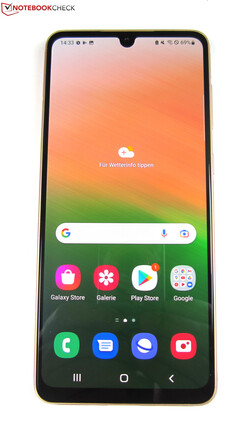
Samsung's Galaxy A33 5G is a solid mid-range smartphone that is already available for US$ 279.98 (at the time of writing). Solid system performance, a bright display and good battery runtimes all ensure reliable use in everday life.
Samsung has improved a number of areas compared with the predecessor. Instead of a rather colorless TFT-LCD, the Galaxy A33 5G is equipped with an impressive high-contrast 90 Hz AMOLED panel, which is not yet standard in this price range. Another selling point is the long update period promised by Samsung - if you take the manufacturer at its word, Android 16 will also be available for the Galaxy A33 5G. Although the camera module has hardly changed, the main camera now comes with optical image stabilization.
The Samsung Galaxy A33 5G is a solid mid-range smartphone that outdoes its predecessor in many respects and comes close to the Galaxy A53 5G.
Admittedly, not everything about the Galaxy A33 5G is worthy of praise. Like the predecessor, there is still only hybrid dual-SIM, the storage memory is definitely not the fastest, and there are few performance issues overall as well as occasional stutters during operation. Another downside is that Samsung has eliminated the jack and charges extra for the 25-watt power supply.
With its strong performance, the Galaxy A33 5G gives the Galaxy A53 5G, which is one step higher in the Galaxy A hierarchy, a run for its money. Aside from the larger form factor, better camera, 120 Hz display and more storage options, both smartphones are virtually identical in terms of battery, communication modules and SoC. Even on the outside, the differences are marginal: The Galaxy A53 5G's selfie camera is not in a teardrop notch like in the Galaxy A33 5G, but in a circular recess.
Alternatives to the Samsung Galaxy A33 5G are, for example, the Motorola Moto G200 5G, the Oppo A76 and the Xiaomi Poco M4 Pro 5G, which also have a 90 Hz screen and are priced very similarly. The Motorola Moto G200 5G is also much more powerful than the Galaxy A33 5G due to its Snapdragon 888 Plus 5G.
The Samsung Galaxy A33 5G is available via Amazon in various colors at various prices, depending on the country of purchase. For example:
US, starting at US$ 267.49
UK, starting at GBP £231.98
Canada, starting at CAD$ 408.04
Australia, starting at AUD$ 485.60
Samsung Galaxy A33 5G - 2022-06-27 06/27/2022 v7
Manuel Masiero
Smartphone - Weighted Average
Pricecompare

My fascination for computers started with the C64. Since then, I've put everything that comes my way in terms of hardware through its paces. From the C64 to the Amiga 500 and the first PC with an 8088 CPU, my list of projects has grown increasingly longer. For more than 20 years now I have also turned my hobby into my profession and have been active in the mobile section of Notebookcheck since 2021. Before that, I worked as a hardware editor for IDG Media (tecChannel.de) and VNU Business Publications (PC professional), among others.

Growing up in regional Australia, I first became acquainted with computers in my early teens after a broken leg from a football (soccer) match temporarily condemned me to a predominately indoor lifestyle. Soon afterwards I was building my own systems. Now I live in Germany, having moved here in 2014, where I study philosophy and anthropology. I am particularly fascinated by how computer technology has fundamentally and dramatically reshaped human culture, and how it continues to do so.
Manuel Masiero, 2022-06-30 (Update: 2022-06-30)
Source: https://www.notebookcheck.net/Samsung-Galaxy-A33-5G-review-Better-than-its-predecessor-in-almost-every-area.632504.0.html
0 Response to "Android Tablet Usb C Blue Teardrop Connection Error"
Post a Comment